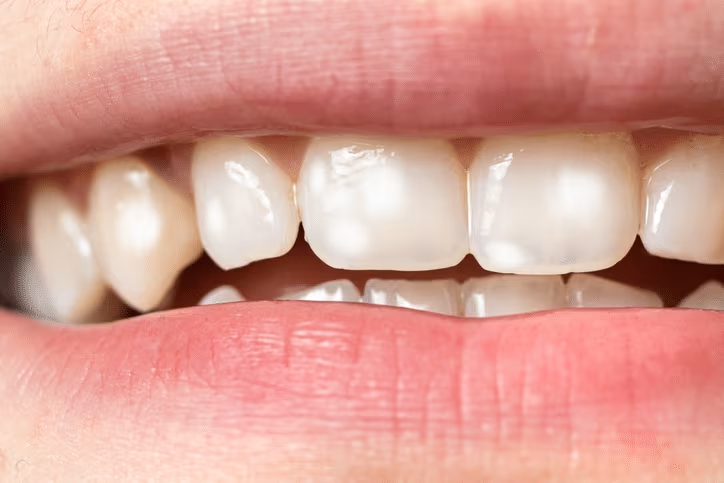Have you noticed white spots that are prominently visible on the surfaces of your teeth? If you have, you may find them quite perplexing.
Many people live with this condition without ever understanding why these white spots formed or how to effectively treat them.
White spots on teeth, technically called white spot lesions, are discrepant white patches that appear on the tooth’s surface. These spots are usually caused by a loss of mineral content in the tooth enamel, a condition known as hypomineralization. While they might seem like just a cosmetic concern, these spots can sometimes indicate more serious dental issues that require attention.
What Causes White Spots on Teeth?
White spots can appear on teeth for various reasons. Understanding the underlying cause is crucial for determining the most effective treatment approach. Here are the main causes:
1. Dental Fluorosis
Dental fluorosis develops when too much fluoride is consumed, particularly at a young age when teeth are still forming. This typically occurs before teeth break through the gums.
Excessive fluoride can come from:
- Swallowing toothpaste
- Drinking overly fluoridated water
- Taking fluoride supplements
With fluorosis, teeth may develop chalky white, yellow, or brownish discolorations depending on severity.
2. Enamel Hypoplasia
Enamel hypoplasia occurs when tooth enamel doesn’t form properly, resulting in thinner enamel than normal. This condition can lead to increased tooth decay and the formation of white spots as a consequence.
Factors that can cause enamel hypoplasia include:
- Hereditary factors
- Vitamin deficiencies
- Medications given to a mother before birth
- Trauma to teeth
- Preterm births
- High fever during illness in childhood
3. Demineralization
Demineralization creates white areas of decalcification on the tooth enamel, resulting from the accumulation of bacterial plaque. This is often caused by poor oral hygiene and is commonly seen in people who wear braces.
These white spots are essentially early cavities that can be reversed if treated quickly. When plaque builds up on teeth, the bacteria produce acids that leach minerals from your enamel, creating these weakened, white-colored areas.
4. Diet and Lifestyle Factors
Several dietary and lifestyle factors can contribute to white spot formation:
- Acidic Foods and Drinks: Citrus fruits, tomatoes, vinegar, and other acidic foods can erode enamel.
- Sugary Foods and Beverages: High sugar consumption stimulates bacteria growth, leading to acid production that damages enamel.
- Poor Oral Hygiene: Inadequate brushing and flossing allows plaque to accumulate.
- Dry Mouth: Reduced saliva flow means less natural protection against acids and bacteria.
- Excessive Brushing: Overly aggressive brushing can wear down enamel.
5. Nutritional Deficiencies
A diet low in essential minerals such as calcium and vitamin D can weaken enamel and potentially lead to white spot formation. These nutrients are crucial for maintaining strong tooth structure.
Effects of White Spots on Oral Health
White spots on teeth aren’t just a cosmetic concern. They can indicate and lead to several oral health issues:
Enamel Loss
When white spots appear, they often signify enamel loss. This weakening makes teeth more vulnerable to damage and decay.
Potential Tooth Decay
White spots can be early warning signs of cavities. If left untreated, these areas can develop into full tooth decay, potentially requiring more extensive dental work.
Tooth Sensitivity
The thinning of enamel associated with white spots can lead to increased tooth sensitivity, causing discomfort when consuming hot, cold, sweet, or acidic foods and drinks.
Risk of Discoloration
White spots create an uneven tooth color, affecting the overall appearance of your smile. Over time, these areas may become further discolored if not addressed.
Treatment Options for White Spots on Teeth
Fortunately, several effective treatments are available to address white spots on teeth. The appropriate option depends on the cause, severity, and individual preferences.
1. Teeth Whitening
Professional teeth whitening or bleaching can help reduce the appearance of not just white spots but also other stains on teeth. There are generally two types:
- In-office (chairside) whitening: Performed at the dental office, this procedure uses stronger bleaching agents for more immediate results.
- At-home bleaching kits: Prescribed by dentists, these contain weaker solutions for gradual whitening at home.
However, it’s important to note that traditional whitening might not always be effective for white spots and could potentially make them more noticeable by whitening the surrounding enamel.
2. Dental Veneers
Dental veneers are thin, protective coverings that attach to the front surface of teeth. They effectively conceal white spots and other blemishes, creating a uniform appearance.
- Porcelain veneers: These custom-made, thin shells are designed to cover the front surface of teeth, resulting in a natural-looking white appearance. They’re highly durable but more expensive.
- Composite veneers: Similar to porcelain veneers but made from resin, these are less costly but may not last as long.
3. Enamel Microabrasion
During this procedure, a dentist removes a small amount of enamel from the teeth to reduce the appearance of white spots or other discolorations. This technique essentially “polishes” away the outer layer of enamel where the white spots are most visible.
4. Resin Infiltration
Dental composite resins (tooth-colored fillings) can cover inconsistencies including white spots on teeth. This treatment involves applying a low-viscosity resin that penetrates and fills the microporosities in the enamel, masking the white spots.
5. Topical Fluoride Treatment
For cases involving enamel hypoplasia or early demineralization, fluoride treatment can be beneficial. This treatment:
- Encourages remineralization of the enamel
- Helps prevent further decay
- Strengthens the existing tooth structure
6. ICON Treatment
A relatively newer treatment called ICON (Infiltration Concept) involves applying a resin material that infiltrates the porous enamel, filling in the microporosities and eliminating the whitish appearance without removing healthy tooth structure.
Prevention of White Spots on Teeth
Preventing white spots is much easier than treating them. Here are effective strategies to maintain healthy, spot-free teeth:
Maintain Good Oral Hygiene
- Brush teeth at least twice daily for two minutes using fluoride toothpaste
- Floss daily to remove plaque and food particles between teeth
- Consider using an antimicrobial or fluoride mouthwash
Proper Fluoride Usage
- Use the appropriate amount of fluoride toothpaste:
- For children under 3: Use a rice-sized amount
- For children 3-6: Use a pea-sized amount
- Supervise young children during brushing to ensure they don’t swallow toothpaste
- Consider discussing fluoride levels in your tap water with your dentist
Dietary Considerations
- Limit consumption of acidic and sugary foods/drinks
- Rinse mouth with water after consuming acidic foods
- Consider using a straw when drinking acidic beverages
- Maintain a diet rich in calcium, phosphorus, and vitamin D
Regular Dental Check-ups
- Schedule dental examinations and cleanings every six months
- Address any signs of decay promptly
- Consider professional fluoride treatments if recommended
Special Considerations for Orthodontic Patients
If you wear braces, you’re at higher risk for developing white spots. Take these extra precautions:
- Use special orthodontic brushes to clean around brackets and wires
- Consider water flossers or floss threaders to clean between wires
- Ask your orthodontist about fluoride rinses or gels specifically designed for braces wearers
When to Consult a Dentist
You should consult a dental professional if:
- You notice new or worsening white spots on your teeth
- You experience increased tooth sensitivity
- You’re concerned about the appearance of existing white spots
- You have children with developing teeth and are unsure about proper fluoride use
A dentist can evaluate the cause of white spots and recommend appropriate treatment options based on your specific situation.
Table: Treatment Options Based on Causes
| Cause | Recommended Treatments | Prevention Strategies |
|---|---|---|
| Dental Fluorosis | Microabrasion, Veneers, Teeth whitening, ICON treatment | Monitor fluoride intake, Use appropriate toothpaste amount, Check water fluoride levels |
| Enamel Hypoplasia | Topical fluoride, Composite bonding, Veneers, Crowns | Regular dental check-ups, Calcium-rich diet, Address underlying causes |
| Demineralization | Topical fluoride, ICON treatment, Improved oral hygiene | Thorough brushing/flossing, Fluoride rinses, Regular dental cleanings |
| Poor Oral Hygiene | Professional cleaning, Topical fluoride, Improved hygiene routine | Consistent brushing/flossing, Regular dental check-ups, Antimicrobial rinses |
| Post-Orthodontic | ICON treatment, Microabrasion, Whitening | Special cleaning tools for braces, Fluoride rinses, More frequent dental check-ups |
Outlook
While white spots on teeth can be concerning, they’re usually not a serious health issue. However, people with enamel hypoplasia may be at increased risk for dental damage and decay, requiring more vigilant care.
The good news is that with proper identification of the cause and appropriate treatment, white spots can often be significantly reduced or eliminated. Early intervention is key to preventing more serious dental problems and maintaining a healthy, attractive smile.
Remember that dental health is an integral part of overall well-being, and addressing issues like white spots can contribute to improved confidence and quality of life.
Frequently Asked Questions (FAQ)
Are white spots on teeth permanent?
Not necessarily. Many treatments can reduce or eliminate white spots, depending on their cause and severity. Early intervention typically yields better results.
Do white spots on teeth indicate cavities?
White spots can be early signs of demineralization, which is the first stage of tooth decay. However, not all white spots are pre-cavities; they may also be caused by fluorosis or enamel hypoplasia.
Can white spots on teeth go away on their own?
Very minor cases of demineralization may remineralize with improved oral hygiene and fluoride use. However, most established white spots require professional treatment to improve their appearance.
Are white spots on children’s teeth normal?
White spots aren’t “normal,” but they’re common. In children, they’re often due to fluorosis or developmental conditions. A pediatric dentist should evaluate any white spots on a child’s teeth.
Does teeth whitening help with white spots?
Traditional teeth whitening may not be effective for white spots and sometimes makes them more noticeable by whitening the surrounding enamel. Specialized treatments like microabrasion or resin infiltration are often more effective.
How can I prevent white spots when wearing braces?
Maintain excellent oral hygiene by brushing after every meal, using fluoride toothpaste, flossing daily, and using tools specifically designed for cleaning around brackets and wires. Regular dental check-ups throughout orthodontic treatment are also essential.
What’s the difference between white spots and calcium deposits on teeth?
These terms are often used interchangeably. What people call “calcium deposits” on teeth are typically areas of demineralization or fluorosis, which appear as white spots.
Can certain foods remove white spots on teeth?
No food can remove established white spots. Some foods rich in calcium and phosphates may help strengthen enamel generally, but they cannot reverse existing white spots.
Is fluoride good or bad for white spots?
It depends on the cause. Fluoride is beneficial for preventing decay and can help remineralize early demineralization. However, excessive fluoride intake during tooth development can cause fluorosis, which appears as white spots.
How much do treatments for white spots typically cost?
Treatment costs vary widely depending on the procedure, location, and dental provider. Minor treatments like fluoride application may cost $20-$50, while veneers can range from $800-$2,500 per tooth. Dental insurance may cover some treatments, particularly if they’re deemed medically necessary rather than purely cosmetic.

